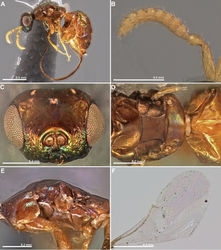Conidarnes
| Notice: | This page is derived from the original publication listed below, whose author(s) should always be credited. Further contributors may edit and improve the content of this page and, consequently, need to be credited as well (see page history). Any assessment of factual correctness requires a careful review of the original article as well as of subsequent contributions.
If you are uncertain whether your planned contribution is correct or not, we suggest that you use the associated discussion page instead of editing the page directly. This page should be cited as follows (rationale):
Citation formats to copy and paste
BibTeX: @article{Farache2015ZooKeys, RIS/ Endnote: TY - JOUR Wikipedia/ Citizendium: <ref name="Farache2015ZooKeys">{{Citation See also the citation download page at the journal. |
Ordo: Hymenoptera
Familia: Agaonidae
Name
Conidarnes Farache & Rasplus gen. n. – Wikispecies link – ZooBank link – Pensoft Profile
Type species
Conidarnes santineloi Farache & Rasplus, sp. n.
Diagnosis
Antennae with 13–14 antennomeres (one or two anelli), including a stub or nipple-like terminal flagellomere. Funicular segments slightly longer than wide to transverse. Antennae inserted at the middle line of compound eyes or below. Toruli contiguous. Clypeal margin bilobed. Malar sulcus absent. Petiole very short, transverse. Ovipositor sheaths without a median constriction and depigmentation.
Generic description
Females. Size and colour. Body length 1.5–4.0 mm. Length of the ovipositor sheaths 0.4–6.4 mm. Body colour variable. Antennae mostly yellow, sometimes with orange or brown tinges. Head and mesosoma brown to black, usually with green, blue and orange metallic lustre. Legs yellow to brown. Coxae sometimes concolorous with mesosoma. Wings hyaline, sometimes medially infuscate in males. Metasoma usually brown black, sometimes yellow.
Head. Antenna with 13 or 14 antennomeres (including a stub or nipple-like terminal antennomere), usually with two anelli but sometimes with a single anellus (antennal formula 11263 or 11163). Terminal antennomere (i.e. a nipple-like thirteenth or fourteenth antennomere) sometimes conspicuous. Funicular segments slightly longer than wide to transverse. Face sculpture usually reticulate, sometimes slightly engraved. Upper face sometimes smooth. Antennae inserted at the middle line of compound eyes or below. Toruli contiguous, distance between toruli always smaller than one torulus diameter. Clypeal margin bilobed. Malar sulcus absent.
Mesosoma. Pronotum and mesonotum sculpture variable. Pronotum longer than high in lateral view. Notauli usually complete, but incomplete in Conidarnes laevis sp. n. Mesoscutellar-axillar complex with straight or incurved axillular grooves and transverse frenal sulcus, forming a square mesoscutellum (an apomorphy of Sycophaginae). Mesoscutellum trapezoidal, wider near frenal sulcus and narrower near transscutal articulation. Propodeum transverse. Wings with short and sparse pilosity. Postmarginal vein inconspicuous, stub-like. Marginal vein at least as long as stigmal vein.
Metasoma. Petiolate, petiole very short, transverse. Margin of eighth gastral tergite deeply sinuate, A-like, with thumbnail-like medial flap (epipygium) and with a peg-like cercus arising from the membrane on either side of the epipygium (apomorphy of Sycophaginae). Length of the ovipositor sheaths varying from 0.3× (about as long as the hind tibia) to nearly twice as long as body. Ovipositor sheaths without a median constriction and depigmentation.
Males. Similar to females but usually slender and shorter. Exhibiting different coloration, the mesosoma sometimes mostly yellow. Wings sometimes medially infuscate.
Etymology
The generic name is masculine and derived from Idarnes Walker, 1843, in the same manner than other sycophagine genera (Pseudidarnes Girault, 1927 and Anidarnes Bouček, 1993) and is associated to the prefix Con used for Conosycea, the host plant section of the included species. The origins of the name Idarnes were discussed in Farache et al. (2013)[1].
Key to species
Original Description
- Farache, F; Rasplus, J; 2015: Conidarnes, a new oriental genus of Sycophaginae (Hymenoptera, Agaonidae) associated with Ficus section Conosycea (Moraceae) ZooKeys, (539): 119-145. doi
Images
|
Other References
- ↑ Farache F, Cruaud A, Genson G, Pereira R, Rasplus J (2013) Taxonomic revision and molecular phylogeny of the fig wasp genus Anidarnes Bouček, 1993 (Hymenoptera, Sycophaginae). Systematic Entomology 38: 14–34. doi: 10.1111/j.1365-3113.2012.00644.x








